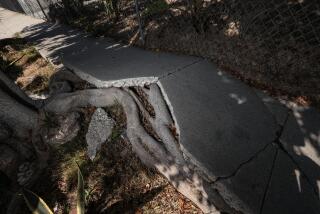How to untangle gridlock
EVERYONE IN LOS ANGELES knows we can’t do anything about traffic congestion. We complain about it, but gridlock just keeps getting worse. Each year, the typical rush-hour traveler wastes 93 hours — more than two workweeks — stuck in traffic. Under current plans, congestion will drive up travel delays by another 11% over the next 25 years, ensuring that L.A. remains the congestion capital of the nation.
Even our regional planners resign themselves to ever-worsening congestion. The passage of Proposition 1B, which allows the state to sell $19.9 billion in bonds for transportation, still doesn’t generate enough money to pay for all the improvements we need. We’re restrained by technical problems, and we don’t have space for new lanes.
Yet other cities of the world have faced the same challenges without surrendering to congestion.
Melbourne, Australia, found room for roads in places many Angelenos overlook. When urban traffic slowed to a crawl, Aussies built elevated structures that weave through commercial districts and tunnels that plunge under residences and city parks.
Other planners are also using innovative highway design to improve traffic flow and preserve the urban fabric of the city. In France, the A86 West Tunnel will complete the “super ring road” around Paris by laying 6.2 miles of two-level, two-lane traffic under Versailles.
In Los Angeles, tunneling could fill in the missing link and connect the 710 Freeway to the 210. But naysayers point to the Big Dig — the fiasco in Boston that went extravagantly over budget and proved fatal when tiles fell from a tunnel roof last summer. Earthquakes make Angelenos especially wary of tunnels.
But the Big Dig is an anomaly. When officials follow best practices, tunnels offer cost-effective solutions to regional traffic problems. And tunnels have proven safe even in seismically active Tokyo.
Building Southern California’s roads up to needed capacity means getting back into the game of private financing. Toll revenue bonds have paid for multibillion-dollar projects in Australia, Britain, Canada, France and many other nations. California was once a trailblazer in highway finance. In 1989, a groundbreaking but flawed law known as AB 680 yielded Orange County’s 91 Express Lanes, a project that scored many “firsts.” It was 20th century America’s first privately funded toll road, the first without tollbooths and the world’s first experience with “value pricing,” in which variable tolls keep traffic flowing smoothly.
However, a stringent “non-compete” clause in the contract enraged motorists because it stymied other roadway projects. The controversy subsided only after the local transportation agency bought the facility. Since then, other nations — as well as more than 20 U.S. states — have ironed out problems that hampered earlier public/private partnership legislation, and today contractors no longer insist on rigid non-compete clauses. But instead of improving AB 680, the state shifted into reverse and repealed it in 2002. Transportation innovation stalled in California but took off overseas.
The right law could help California catch up to the rest of the world by again allowing private investors to relieve gridlock. Such legislation would be especially welcome in Southern California, the region former Secretary of Transportation Norman Mineta called “the most attractive [road] investment opportunity in America, if not the world.”
Imagine if we could expand the 91 Express Lanes model and transform our carpool-lane network into a regionwide network of special toll lanes. Motorists could pay to swerve past congestion, and bus riders could finally enjoy speedy travel. If the project proved too much for one contractor, multiple contractors could bid on different parts of the network.
That strikes many as unthinkable; everyone knows that greedy private companies wouldn’t work together for the good of the whole system. Yet they’ve done just that in Santiago, Chile. Four private companies have just completed an integrated, 97-mile network of toll-financed roads. Tolls are collected electronically, and motorists need only sign up with one company to gain access to any and all of the tollways.
Unlike conventional bond financing, private funding places financial risk on investors, not taxpayers. There’s also the issue of fairness; only those who use toll roads pay for them. Politicians often shy away from tolling because they fear backlash from voters. Yet London Mayor Ken Livingstone pushed for tolling and won reelection. And there’s evidence that motorists are warming to the idea of tolling new capacity. A recent Mineta Transportation Institute survey revealed that Californians prefer tolls to bonds or higher gas taxes.
Los Angeles should draw inspiration from other cities of the world and embrace the solutions that will allow us to escape our fatalistic view of congestion.
More to Read
All things Lakers, all the time.
Get all the Lakers news you need in Dan Woike's weekly newsletter.
You may occasionally receive promotional content from the Los Angeles Times.






